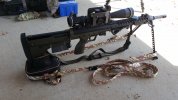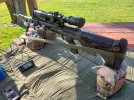In the world of benchrest shooting, their rifles are configured with either a flat forearm or an attached flat plate and a rear horizontal bar to slide in the rear bag,,, all for stability and consistency. QUESTION: Is it an advantage to have a similiar setup for load development ? I realize that the point of impact will change once the attachments have been removed. Or put another way, should one try to reduce or almost eliminate the human factor during this process ? Once the recipe is achieved, remove the attachments, place the rifle in a more traditional rest, sight in the scope, and go hunting.
You are using an out of date browser. It may not display this or other websites correctly.
You should upgrade or use an alternative browser.
You should upgrade or use an alternative browser.
RIFLE SETUP FOR LOAD DEVELOPMENT
- Thread starter kuduman
- Start date
 Help Support Long Range Hunting Forum
Help Support Long Range Hunting Forum
Beardeddeer91
Well-Known Member
In my opinion I want to develop a load that works will for the rifle system as I'm going to use it. That means using the stock I'm going to use, barrel attachement (I.e., brake or can), and shooting from the rest that I'll use hunting (bipod and rear bag). That's not to say I am not going to be as steady as possible and take as long as I need at the range to make accurate shots (I'm never in a rush shooting when developing a load). Changing anything that influences the barrel or the interface to you (stock) defeats the purpose for me. Using a good front bench rest and rear bag where the rifle can still recoil correctly (I.e., not a lead sled) should also work well shooting off a bench IMO.
memtb
Well-Known Member
I think that Beardedder91 pretty much nailed it. I think..... "Shoot it, the way you will use it"! I do not use any "felt recoil" reducing methods (lead sled, ect) with load development or zeroing. I do however, use a bench....as load development/zeroing would be futile without it. But, I do try to replicate as closely as possible, the way will be rifle will be held/supported in the field! Once done with development and zeroing, I then shoot from my shooting sticks to verify my zero hasn't altered! memtb
marchboom
Well-Known Member
During load development elimination of variables is key. Following benchrest techniques to minimize shot-to-shot inconsistencies helps to isolate the differences in group sizes to the load itself. If you add too many variables to the set-up you won't know where the problem is. Using the free recoil method will take YOU out of the results too. When you have found a load that you are satisfied with, then you can take off any attachments from the rifle that you will not be using while hunting or shooting in competition. Sight-in off the same rest, ruck, log, freehand, etc. that you will be using in the field and you should be ready to go.
Rardoin
Well-Known Member
^^^ I have developed loads, for a rifle destined to be shot free-hand or off of a bipod/prone, using a detachable forearm bag rider so I could fully rest it in a SEB Neo/heavy prone rear bag. I found that it shot essentially the same grouping pattern with either method except I had less out of group shots and less horizontal fully rested. For a hunting load a fully rested rifle that is allowed to recoil in a similar fashion as when used hunting will group close enough as to not make a difference. However as MB said it is much easier to eliminate the human factor is you have a stable and repeatable method of resting the rifle during load development. On another note I don't like Lead-Sleds at all for other reasons (I've seen groups change going from just using a large sand bag to a LS). I have seen a couple of scopes damaged and one very nice Weatherby 300WM stock split at the tang during firing off a LS weighted with 25lbs of steel .
.
MagnumManiac
Well-Known Member
There are really 2 schools of thought in this.
1) Use a front rest and rear bag to shoot load work ups. Doing this off a proper fixed bench is best.
2) Use a bi-pod and rear bag to shoot work-ups off a solid bench.
Now, my experience with the latter is that unless the bi-pod is heavily loaded, I would get inconsistent grouping due to recoil bounce. The only fix was to place heavy beach towels under the bi-pod to stop the bouncing and load it up. This is somewhat difficult on a public range where they don't want you clamping timber to their benches. Lol. Just pushing the bi-pod forward against spring pressure isn't always consistent, pushing against a raised piece of timber is far easier.
I develop my loads with a heavy Caldwell front rest, the one with the 'bunny ears' bag. This is what I shoot my groups with also when not testing my comp rifles that have their own system.
Hope this makes sense, just woke up.
Cheers.
1) Use a front rest and rear bag to shoot load work ups. Doing this off a proper fixed bench is best.
2) Use a bi-pod and rear bag to shoot work-ups off a solid bench.
Now, my experience with the latter is that unless the bi-pod is heavily loaded, I would get inconsistent grouping due to recoil bounce. The only fix was to place heavy beach towels under the bi-pod to stop the bouncing and load it up. This is somewhat difficult on a public range where they don't want you clamping timber to their benches. Lol. Just pushing the bi-pod forward against spring pressure isn't always consistent, pushing against a raised piece of timber is far easier.
I develop my loads with a heavy Caldwell front rest, the one with the 'bunny ears' bag. This is what I shoot my groups with also when not testing my comp rifles that have their own system.
Hope this makes sense, just woke up.
Cheers.
memtb
Well-Known Member
I worked up loads years ago shooting off a concrete bench at our gun club. The gun was a hard recoiler and I had to make sure that I had something under my elbow or I would loose some skin.
I use a towel and wear a volleyball elbow pad.....or get a good case of "carpet burn"! 60 ft/lbs of recoil tends to move you around a bit!
Mikecr
Well-Known Member
My hunting guns are load developed as I use them in the field: Harris bipod in the dirt.
My BR guns are developed off bench rest, heavy sand, on bench.
I have found crossing conditions to be counterproductive.
My BR guns are developed off bench rest, heavy sand, on bench.
I have found crossing conditions to be counterproductive.
Jeffrey Van Zandt
Well-Known Member
if this load is for your rifle then do it in your rifle the same way you would shoot it I do all of my work ups off of a bipod for hunting and steelIn the world of benchrest shooting, their rifles are configured with either a flat forearm or an attached flat plate and a rear horizontal bar to slide in the rear bag,,, all for stability and consistency. QUESTION: Is it an advantage to have a similiar setup for load development ? I realize that the point of impact will change once the attachments have been removed. Or put another way, should one try to reduce or almost eliminate the human factor during this process ? Once the recipe is achieved, remove the attachments, place the rifle in a more traditional rest, sight in the scope, and go hunting.
JanPr
Member
I put my barrels in a bench rest stock for testing.Which is easy with the Blaser. Everything over .5 is no good for me.
My avatar is when I won bronze at the Word Champs in 2016, so yes I think I know what I am talking about.
My avatar is when I won bronze at the Word Champs in 2016, so yes I think I know what I am talking about.
Yeah definitely do your bullet development test with those minimal variables as possible then this way you know you have a good round and when you go hunting and screw up you know it's your fault.There are really 2 schools of thought in this.
1) Use a front rest and rear bag to shoot load work ups. Doing this off a proper fixed bench is best.
2) Use a bi-pod and rear bag to shoot work-ups off a solid bench.
Now, my experience with the latter is that unless the bi-pod is heavily loaded, I would get inconsistent grouping due to recoil bounce. The only fix was to place heavy beach towels under the bi-pod to stop the bouncing and load it up. This is somewhat difficult on a public range where they don't want you clamping timber to their benches. Lol. Just pushing the bi-pod forward against spring pressure isn't always consistent, pushing against a raised piece of timber is far easier.
I develop my loads with a heavy Caldwell front rest, the one with the 'bunny ears' bag. This is what I shoot my groups with also when not testing my comp rifles that have their own system.
Hope this makes sense, just woke up.
Cheers.
hopefully that doesn't happen
WeiserBucks
Well-Known Member
- Joined
- Aug 16, 2016
- Messages
- 2,783
Sight it in freehand huh? What could possibly go wrong?Sight-in off the same rest, ruck, log, freehand, etc. that you will be using in the field and you should be ready to go.
I the event mentioned earlier regarding bipod bounce and not being able to load your bipod in some situations I have developed a nylon strap I use to load my bipod on slippery surfaces. Attached to each bipod leg and around the rear bag, while squeezing the bag and leaning into the bipod it loads very nicely. It can also be used to seriously reduce felt recoil by attaching the ends to a bench and looping it around the butt. This is very good for sighting in and load development, it controls the recoil so you can concentrate on making each shot count. Saving money too! I call it the "Shooter's Slingshot"
You can make one for about $5 from a good hardware store. I carry one in my kit, it is very handy, light weight and a lot easier to carry than a lead sled.
You can make one for about $5 from a good hardware store. I carry one in my kit, it is very handy, light weight and a lot easier to carry than a lead sled.

